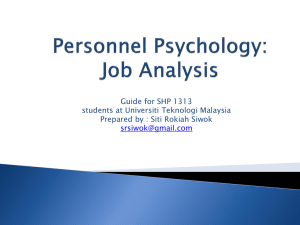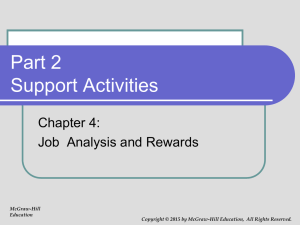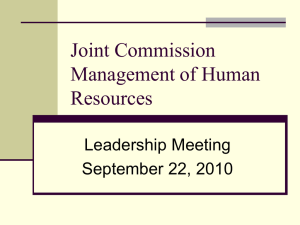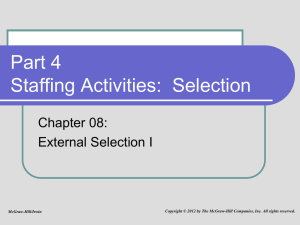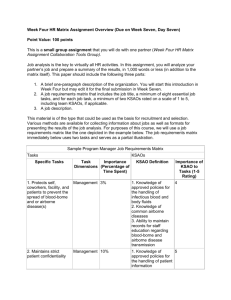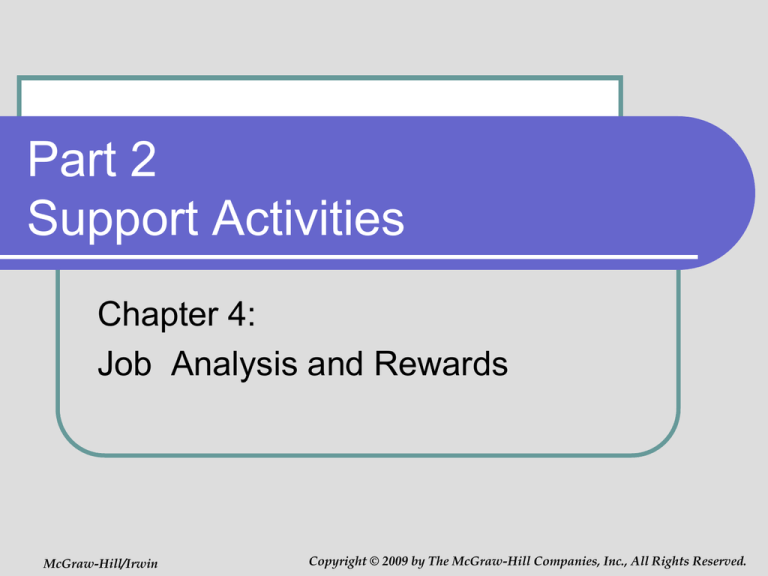
Part 2
Support Activities
Chapter 4:
Job Analysis and Rewards
McGraw-Hill/Irwin
Copyright © 2009 by The McGraw-Hill Companies, Inc., All Rights Reserved.
Staffing Organizations Model
Organization
Mission
Goals and Objectives
Organization Strategy
HR and Staffing Strategy
Staffing Policies and Programs
Support Activities
Core Staffing Activities
Legal compliance
Planning
Job analysis
Recruitment: External, internal
Selection:
External, internal
Employment:
Decision making & final match
Staffing System and Retention Management
4-2
Chapter Outline
Changing Nature of Jobs
Job Requirements Job
Analysis
Job Requirements Matrix
Job Descriptions and Job
Specifications
Collecting Job
Requirements Information
Competency-Based Job
Analysis
Nature of Competencies
Collecting Competency
Information
Job Rewards
Types of Rewards
Employee Value
Proposition
Collecting Job Rewards
Information
Job Analysis for Teams
4-3
Discussion Questions for This
Chapter
How should task statements be written, and what sorts of
problems might you encounter in asking a job incumbent to write
these statements?
Would it be better to first identify task dimensions and then create
specific task statements for each dimension, or should task
statements be identified first and then used to create task
dimensions?
What would you consider when trying to decide what criteria (e.g.,
percent time spent) to use for gathering indications about task
importance?
What are the advantages and disadvantages of using multiple
methods of job analysis for a particular job? Multiple sources?
What are the advantages and disadvantages of identifying and
using general competencies to guide staffing activities?
Identify a team-based job situation. What are examples of jobspanning KSAOs required in that situation?
4-4
Changing Nature of Jobs
Jobs are constantly evolving
The traditional way of designing a job
Identify and define its elements and tasks precisely
Shortcomings of the traditional view
Jobs are constantly evolving
Flexible jobs have frequently changing task and
KSAO requirements
Need for new, general skills or competencies like
teamwork and engagement
4-5
Exhibit 4.1 Terminology Used in
Describing Jobs
Job family
Job category
A grouping of similar types of tasks
Task
A grouping of tasks/dimensions that constitute the total work assignment of a
single employee
Task dimension
A grouping of positions that are similar in their tasks and task dimensions
Position
A grouping of jobs according to generic job title or occupation
Job
A grouping of jobs, usually according to function
A grouping of elements to form an identifiable work activity
Element
The smallest unit into which work can be divided
4-6
Job Requirements Job Analysis:
Overview
Definition
Process of studying jobs to gather, analyze, synthesize/blend,
and report information about job requirements
Two major forms
Job requirements
Competency based
Specific KSAOs for the job
General KSAOs for all applicants
Has different degrees of relevance to staffing activities
Support activity for staffing activities
Provides foundation for successful staffing systems
4-7
Ex. 4.2: Job Requirements
Approach to Job Analysis
4-8
Ex. 4.3 Job Requirements Matrix
4-9
Task statements
Definition
objectively written descriptions of the behaviors or
work activities engaged in by employees in order to
perform the job
Each statement should include
What the employee does, using a specific action verb
To whom or what the employee does what he or she
does, stating the object of the verb
What is produced, indicating the expected output of
the verb
What equipment, materials, tools, or procedures,
are used
4-10
Task Dimensions
Definition
Involves grouping sets of task statements into dimensions,
attaching a name to each dimension
Other terms -- “duties,” “accountability areas,”
“responsibilities,” and “performance dimensions”
Characteristics
Creation is optional
Many different grouping procedures exist
Guideline - 4 to 8 dimensions
Grouping procedure should be acceptable to organizational
members
Empirical validation against external criterion is not possible
4-11
Exh. 4.4: Use of Sentence Analysis
Technique for Task Statements
4-12
Importance of Tasks/Dimensions
Involves an objective assessment of importance
Two decisions
Decide on attribute to be assessed in terms of
importance
Decide whether attribute will be measured in
categorical or continuous terms
Ex. 4.5: Ways to Assess Task/Dimension
Importance
Relative time spent
Percentage (%) time spent
Importance to overall performance
Need for new employee training
4-13
KSAOs
What are KSAOs?
Knowledge
Skill
Exh. 4.7: Skills Contained in O*NET
Ability
Exh. 4.6: Knowledges Contained in O*NET
Exh. 4.8: Abilities Contained in O*NET
Other Characteristics
Exh. 4.9: Examples of Other Job Requirements
4-14
Exhibit 4.10
Examples of Ways to Assess KSAO Importance
4-15
Discussion questions
How should task statements be written, and what sorts
of problems might you encounter in asking a job
incumbent to write these statements?
Would it be better to first identify task dimensions and
then create specific task statements for each
dimension, or should task statements be identified first
and then used to create task dimensions?
What would you consider when trying to decide what
criteria (e.g., percent time spent) to use for gathering
indications about task importance?
4-16
Job Descriptions and
Job Specifications
Job description
Describes tasks, task dimensions, importance of
tasks / dimensions, and job context
Includes
Job family, job title, job summary
Task statements and dimensions
Importance indicators
Job context indicators
Date conducted
Job specifications
Describes KSAOs
4-17
Collecting Job Requirements
Information
Methods
Prior information
Observation
Interviews
Task questionnaire
Committee or task
force
Sources to be used
Job analyst
Job incumbents
Supervisors
Subject matter
experts
Criteria for guiding choice of job analysis methods – ex.
4.13 – pg. 168
4-18
Exhibit 4.14 Factors to Consider in Choosing
Between Internal Staff or Consultants or Job Analysis
4-19
Exhibit 4.15 Example of Job
Requirements Job Analysis Process
4-20
Competency-Based Job Analysis
Nature of competencies
an underlying/principal characteristic of an
individual that contributes to job or role
performance and to organizational success
Usage reflects a desire to:
Connote/suggest job requirements that extend
beyond the specific job itself
describe and measure the organization’s workforce
in more general terms
as a way of increasing staffing flexibility in job
assignments
4-21
KSAOs or Competencies?
Similarities between competencies and
KSAOs
Both reflect an underlying ability to perform a job
Differences between competencies and
KSAOs
Competencies are much more general
May contribute to success on multiple jobs
Contribute not only to job performance but also to
organizational success
4-22
Exh. 4.16: Examples of Competencies
4-23
Organization Usage
Organizations are experimenting with
Three strategic HR reasons for doing competency
modeling
Developing competencies and competency models and
Using them as underpinnings of several HR applications
Create awareness and understanding of need for change in
business
Enhance skill levels of workforce
Improve teamwork and coordination
Emphasis -- Establishing general competencies
4-24
The “Great Eight” Competencies
Leading: initiates action, gives direction
Supporting: shows respect, puts people first
Presenting: communicates and networks
effectively
Analyzing: thinks clearly, applies expertise
Creating: thinks broadly, handles situations
creatively
Organizing: plans ahead, follows rules
Adapting: responds to change, copes with
setbacks
Performing: focuses on results, shows
understanding of organization
4-25
Collecting Competency Information
Techniques and processes are in their infancy
General competencies at the organizational
/strategic level are established by top
management
Guidelines for establishing general
competency requirements
Organization must establish its mission and goals
prior to determining competency requirements
Should be important at all job levels
Should have specific, behavioral definitions, not just
labels
4-26
Discussion Questions
What are the advantages and
disadvantages of using multiple methods
of job analysis for a particular job?
Multiple sources?
What are the advantages and
disadvantages of identifying and using
general competencies to guide staffing
activities?
4-27
Job Rewards
Extrinsic rewards
Intrinsic rewards
external to the job itself
designed and granted to employees by the organization
pay, benefits, work schedule, advancement, job security
intangibles
experienced by employees as an outgrowth of doing the job
variety in work duties, autonomy, feedback, coworker and
supervisor relations
Employee value proposition
the “package” or “bundle” of rewards provided to employees
and to which employees respond by joining, performing, and
remaining with the organization
4-28
Job Rewards:
Collecting Information
Within the organization
Interviews with employees
Surveys with employees
Outside the organization
SHRM survey
Organizational practices
4-29
Ex. 4.17: Examples of Reward
Preferences Interview Questions
4-30
Job Analysis for Teams
Many team members perform multiple jobs
(rather than a single job)
Staffing must emphasize recruitment and
selection for both job-specific KSAOs and jobspanning KSAOs
Increased importance of KSAOs pertaining to
interpersonal qualities (e.g., communicating,
collaborating, and resolving conflicts) and
team self-management qualities (e.g., setting
group goals, inspecting each other’s work).
4-31
Discussion question
Identify a team-based job situation. What
are examples of job-spanning KSAOs
required in that situation?
4-32

